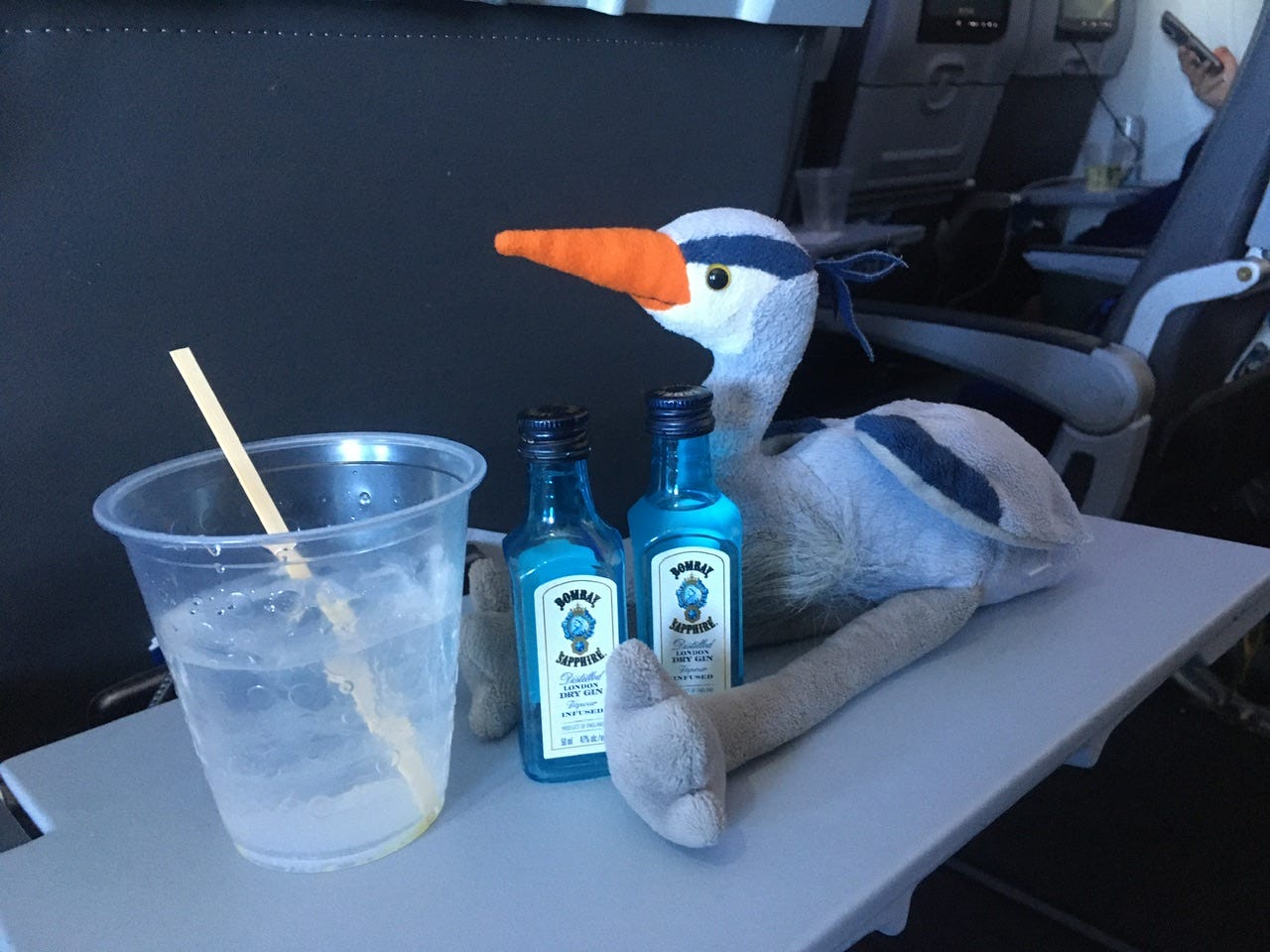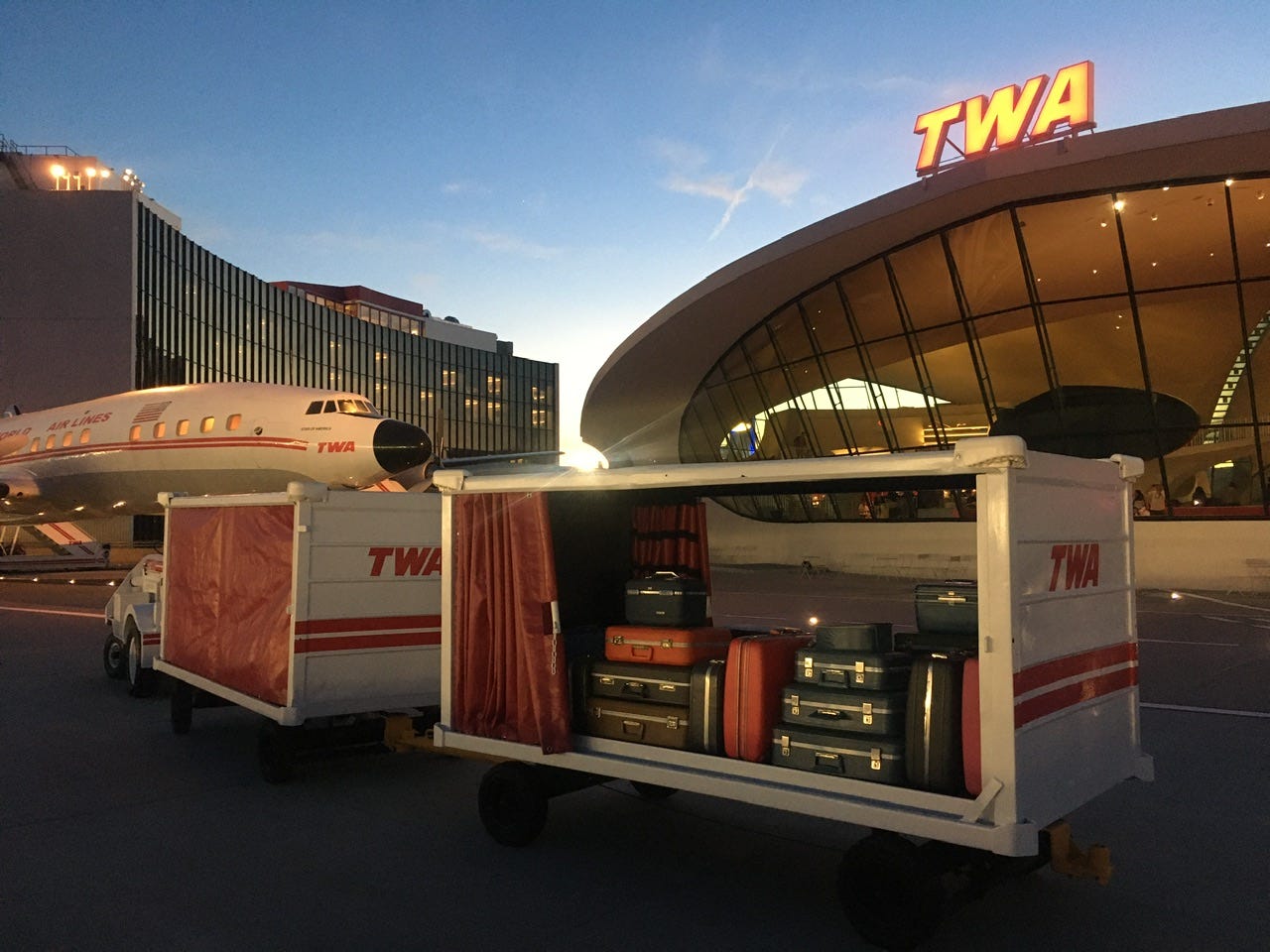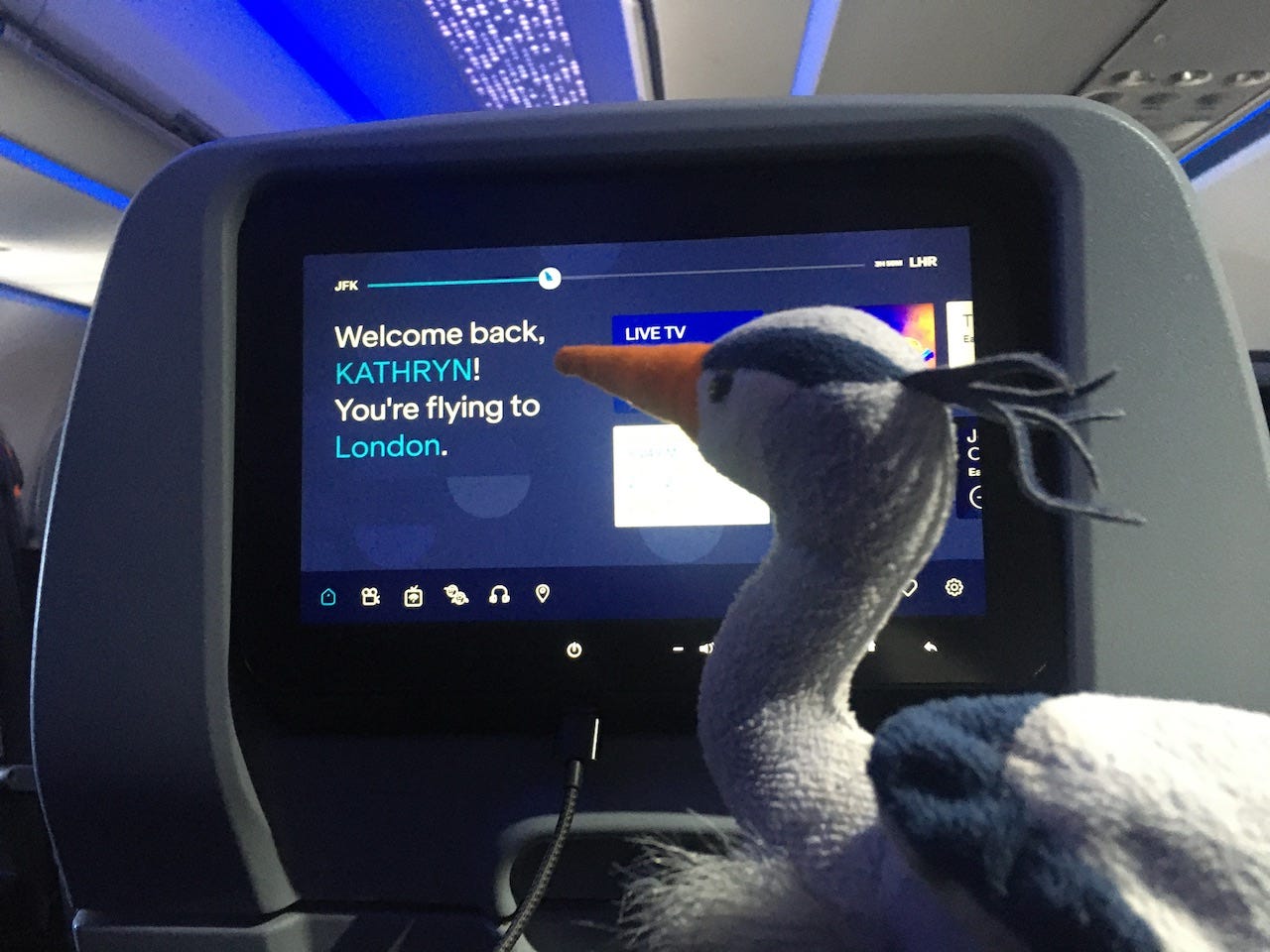I am an American citizen. My heart is in Europe. And I am a side sleeper.
I cannot sleep in an airplane seat in coach. I cannot sleep in an airplane seat in coach in recline position. I cannot sleep in an airplane seat in coach in a window seat with my head propped against the wall. I cannot sleep in coach, Sam am I. (I am only able to manage a bit of poor sleep in a nearly empty flight in which passengers are able to claim their own rows in which to “lie down” – but when was the last time that you were lucky enough to board a transatlantic flight like that?) Moreover, I am far too old to find any appeal in the idea of an all-nighter, and on top of all that, I’m among the numerous individuals who find that overnight flights interfere with – erm – regularity.
As anyone who has travelled from the US to Europe knows, the vast majority of eastbound transatlantic flights are overnight – or red eyes, as we Americans poetically call them. Upgrading to business class will get you lie-flat seats, but it’s hella expensive, and it still doesn’t provide the benefits of a full night’s rest and a shower. But it doesn’t have to be like this. There is a better way…
Enter [heavens open with a beam of light and angelic music plays] daytime eastbound transatlantic flights [“Hallelujah chorus” crescendos].
If you are like me, then you feel completely beat after the end of a long flight on the heels of an early morning at the airport, and therein lies a further benefit to daytime flights from the US to Europe: it is easier to pass out at a reasonable hour, even in the new time zone, and you might find (as I do) that you beat jetlag on the first day.
This post is an unusual entry in the Nonmotorized Trails catalogue in that it is not related to car-free explorations of nature – not directly. However, I would never have been inspired to create Nonmotorized Trails – or, more importantly, to pursue the lifestyle behind it – if I had never travelled from North America to Europe. As it happens, I also learned two other things during my earliest experiences with transatlantic flights: (1) I cannot sleep on airplanes, and (2) I cannot stand sleep deprivation. Thus, it has required significant research and trial and error to return to the lands I love in a manner I find bearable. I have written this post to share the outcomes of those investigations with any others who might find it useful.

I will begin with a list of the presently operative daytime flights from the US to Europe (as of June 2025). But, of course, the transatlantic hop is only one portion of the journey. Most likely, you will need short-term accommodations both before and after this long-haul flight. Thus, I have also included information about the most convenient hotels both pre-departure and post-arrival. I wrap up by commenting briefly on the other options: flying business class or travelling by ship.
Disclaimer for Environmentalists. If anyone wants to complain that it’s wrong to take transatlantic flights in an era of climate change, then feel free to offer me permanent employment in the EU so that I never need to return stateside. I would be most grateful, and I can all-but guarantee that many of the Americans in this post’s target audience feel exactly the same. Note also that (since daytime westbound transatlantic flights are a dime a dozen) I write here only about the escape flight, not the round trip; surely even the most ardent environmentalist can begrudge no American for leaving.
1. The Flight Options (as of June 2025)
There are two main options for ports of entry into Europe via daytime flights from the US: London Heathrow (the destination for the vast majority of daytime eastbound transatlantic flights) and Iceland’s Keflavík. There are also limited seasonal flights to Ponta Delgada in the Azores.
Meanwhile, there are currently three options for ports of departure from the US: New York’s JFK and Newark in addition to Boston Logan. While New York offers the majority of daytime flights to London, Boston claims a monopoly on daytime into the Schengen Area. (There might also be a seasonal daytime flight with American Airlines from Chicago O’Hare to Heathrow, but it appears to be a short-lived summer route, one that seems to be on its way out no sooner than this post is published.)
N.B. If you want to do your own research, or search for connecting flights, I highly recommend FlightConnections.com.
A. Flights from US to EU/Schengen Area
Passport control at Heathrow is automated and consistently fast and easy. That said, if your final destination is in the Schengen Area, then you might prefer to bypass the UK and save yourself an extra trip through passport control. Furthermore, while I can’t comment on the experience at Keflavík International Airport post-pandemic, I frequently used the airport as my port of entry in the late 2010s, and at least at that time, its passport control was a smooth and quick experience. There are worse airports in which to enter the Schengen Area. (I have never used PDL and thus cannot comment on that seasonal option.)
To fly directly into the “borderless” Schengen Area, there are presently only two daytime options, both out of Boston:
a. Boston (BOS) to Keflavík (KEF)
• Icelandair offers flights departing BOS Terminal E at 12:35 local Daylight Time / 11:35 local Standard Time and arriving at KEF at 21:45 local. The flight is daily during summer season, with three departures per week (Th, Sa, Su) in the autumn. For most of the year, this is only daytime direct flight from the US into the Schengen Area.
b. Boston (BOS) to Ponta Delgada (PDL)
• Azores Airlines offers flights departing BOS Terminal E at 11:45 local and arriving at PDL at 20:50 local. This flight currently operates four days per week (Mo, Fr, Sa, Su) during the summer, but it is slated to end for the season after September.
B. Flights from US to UK/Common Travel Area
If you wish to use Heathrow as your port of entry, then you have the option of flying daytime from either Boston or New York City (with the flights out of NYC not departing quite so damn early). Personally, even when my final destination is in the Schengen Area, I almost invariably find it more economical and practical – all things considered – to enter via Heathrow. There are many more options for connecting flights from LHR than either KEF or PDL, even before you take into account possibilities for continuing your journey via another London airport. Furthermore, at least one of the Heathrow hotels will probably cost you less than Keflavík’s one connected hotel, and the speed and frequency of the Heathrow Express makes it reasonable to stay near Paddington Station – a perfect location for an extended layover to see the heronries in Hyde and Regent’s Parks (not to say that Iceland – or São Miguel, for that matter – isn’t worth an extended layover in its own right…).
a. Boston (BOS) to London Heathrow (LHR)
• British Airways / American Airlines (BA/AA) operates a daily flight departing from BOS Terminal E at 7:25 local and arriving at LHR Terminal 5 at 18:55 local. (Unless you really want to fly from Boston, I’d suggest flying from New York as a way to sleep a bit more.)
b. Newark (EWR) to London Heathrow (LHR)
• United Airlines operates a daily flight departing from EWR Terminal C at 8:30 local and arriving at LHR Terminal 2 at 20:40 local. This service is currently scheduled through 25 October 2025, at which point UA is slated to add a second (!) daytime flight from EWR with a later (!) departure time. Although the times vary by the day, it appears that UA will be offering flights leaving Newark as late as 9:10, 9:25 and even 10:10 this autumn. The 10:10 departure is scheduled to arrive in London at the still-reasonable hour of 21:20 local time.
c. JFK (JFK) to London Heathrow (LHR)
• BA/AA has a flight departing from JFK at 7:50 local time, but IMHO that’s too early to bother considering that other options exist, including with the same airline. Moving on…
• Virgin Atlantic offers a flight departing from JFK Terminal 4 at 8:10 local and arriving at LHR Terminal 3 at 20:00 local. This might be your preferred option if you are a dedicated traveller with Virgin or its partner airlines (Delta, KLM, etc) or if you simply prefer to start your day in JFK’s T4 instead of JFK’s T5 or T8 (which would not be unreasonable). In my opinion, however, there are still two better options.
• JetBlue has a flight departing from JFK Terminal 5 at 8:45 local and arriving at LHR Terminal 2 at 20:45 local. Sometimes its departure time is earlier, but never before 8:00.
• BA/AA offers a second and (IMHO) much more reasonably timed flight: one that departs from JFK Terminal 8 at 9:45 local and arrives at LHR Terminal 3 at 21:40 local.
All else being equal, JetBlue is my favorite airline for transatlantic flights. There is free and often functional (!) WiFi, and I find its smaller airplanes – one aisle instead of two – to be less overwhelming than those used for long haul flights by the bigger airlines. JetBlue advertises the “most legroom in coach,” and that might well be true (which is not to say that it’s exactly spacious when you’re trapped behind a passenger reclined to the max…). A self-serve snack/water bar remains open through the long middle period of the flight, between the food service and the pre-arrival snack, and the complementary alcoholic beverages are decent. Furthermore, the ONLY way to catch a morning flight from JFK without using the AirTrain (not so bad) or hotel shuttle (often bad) is to stay at the TWA Hotel and fly from T5 with JetBlue. Since I started using the airline several years ago, it has stopped providing free socks, and the food quality has declined slightly (e.g. there seem to be more flights unequipped to offer hot meals) but it remains my preference – whether for slumming it in coach on its daytime JFK-LHR flight, or for its option to book “Mint” fare (with lie-flat seats) for only the overnight leg of a roundtrip flight (see below).
Of course, in the case of daytime departures from JFK, all else is NOT equal: the second British/American flight has a significantly later departure time, making it more reasonable to stay in an off-terminal hotel, which do possess some advantages over the TWA Hotel (beyond the obvious of saving upwards of $100 on a one-night stay). It is to the topic of relevant airport hotels that I now turn.
This post is NOT sponsored by JetBlue.
2. Hotels Pre-Departure
Although they are much less common in the US than Europe, I am a huge fan of hotels within walking distance of airport terminals. They are my preference whenever I have a one night layover, even if my second flight leaves comfortably late in the day. If I need to be at the airport before 7 am – as in the case of any daytime transatlantic flight to Heathrow – then there’s no f’ing way I’m staying anywhere with a commute that’s longer or less reliable than necessary.
Unfortunately, pre-flight accommodations are the weak link in planning a daytime flight from the US to Europe. Boston, Newark and JFK are all lacking in convenient hotels, and the only two safely walkable hotels out of the entire set – the Hilton at Boston Logan and JFK’s TWA Hotel – are going to cost you (although not as much as an upgrade to business class). It’s just one more example of the superiority of Europe’s infrastructure to America’s – its compactness, its walkability, its greater likelihood to consider humans rather than cars as the basic units of movement… That said, here are the best of the bad options for pre-flight accommodations:
A. Boston Logan
For Boston departures, there is one hotel connected directly to the airport (i.e. walkable to the airport): the Hilton Boston Logan. I do not recommend Boston Logan’s hotels that require a shuttle, unless you want even more reason to be glad to leave America’s car-centric infrastructure. If you want to stay off-airport, you are better off staying downtown and using the Blue Line of the city’s subway system – not an unreasonable plan, IMHO, for a late morning departure with Icelandair or Azores.
B. Newark
I have no personal experience with overnight layovers at Newark, since I have spent some years avoiding this airport. Suffice it to say, though, that it’s not clear whether there is any hotel in safe walking distance from the airport terminals. The Newark Liberty International Airport Marriott is said to be the only hotel “in” the airport, but reviews suggest that it is not safely walkable to the terminals (it requires crossing a busy road with no pedestrian crossing) and use of the shuttle bus is highly advised.
C. JFK
As previously mentioned, the only hotel connected directly to JFK – that is, the only hotel walkable to JFK – is the TWA Hotel at T5. If you fly with JetBlue, the location couldn’t be more convenient. If you fly with Virgin or American/British Airways, then it’s still easy to access the AirTrain to get to your terminal (since it runs frequently and far above the traffic, the AirTrain is not nearly the nuisance that shuttle buses are). If you are nostalgic for Trans World Airlines, you might find the TWA Hotel to be a fun stop in its own right, and one must give it credit for being a departure from your run-of-the-mill Marriotts and Hiltons. But it has one major drawback (aside from the cost and that time the fire alarms went off in the middle of night for no reason): there are no kettles or coffee makers in the rooms [shocked face emoji]. There is also no free coffee in the lobby, no complementary breakfast, not even any paid sit-down breakfast early enough to enjoy before your daytime flight to Heathrow. If you want your pre-security cup of joe, then you will need to go down to the food court area and purchase some overpriced and none-too-fresh coffee in a disposable takeaway cup.
If you prefer coffee in your hotel room, or if you are simply priced out of TWA, then you’ll need to go off-airport (the Marriott and Residence Inn are both fine as far as the rooms go) and endure a shuttle bus ride of up to 30 minutes in traffic, listening to some annoying morning show DJs or maybe praise and worship music.
3. Hotels Post-Arrival
Congratulations, you have arrived in the civilised world. You can now use mass transit to reach your hotel from the airport – no more listening to ads for prayer service apps while your shuttle driver is stuck in stop-and-go traffic. But where will you go…?
Only you know your own body. If you trust jetlag to give you the stamina that you need, then perhaps you will want to avail yourself of the Heathrow Express to Paddington or the Piccadilly Line, so that you can enjoy the nightlife of central London immediately after your arrival. Alternatively, if you fly to Iceland, perhaps you trust that you’ll feel up for the 45-minute ride to Reykjavik with the Flybus.
Personally, though, I feel reliably exhausted after a long day of travel, so I prefer to stay at one of the hotels connected directly to the terminal at which my plane arrives. For Heathrow Terminal 2 or 3, that means either the Hilton Garden Inn or Aerotel. Technically, the former is in T2 and the latter is in T3, but the two terminals are mutually walkable. For Heathrow T5, that means the lovely Sofitel. For KEF, that means the Aurora Hotel. There is no hotel connected to Ponta Delgado’s Joao Paulo II Airport, but let’s face it; you’re probably not going to use that route anyway.

Here are three additional pro-tips regarding the hotels at Heathrow:
1. While I don’t hesitate to recommend the Hilton Garden Inn at T2, one must be very careful when booking it, since there are two Heathrow Hilton Garden Inns – one at T2, the other at Hatton Cross. It is not particularly difficult to reach the Hatton Cross hotel via the tube and a short walk, and the tube is even free from Heathrow to this stop. However, you might be in for disappointment if (hypothetically speaking) you show up at the reception desk, exhausted from your flight and ready to drop off your belongings and grab a drink and snack at the Runway Bar, only to find out that you need to go back to the tube and make a further journey to a different hotel, where the restaurant is closed and the lobby overrun with noisy children.
2. If you prefer to stay at a hotel connected to a different terminal, then go for it; it’s really not that bad to use the Underground to travel between terminals. The signage is good, the trains are frequent, and there’s no charge: just locate a vending machine for an inter-terminal ticket; you should find them near the turnstiles. In addition to the hotels mentioned above, there are few less expensive options connected to T4.
3. I do NOT recommend the Heathrow hotels that require a shuttle bus (e.g. Leonardo and Radisson). Even though you are outside of the US [cue audio clip of cheering people] and it is somewhat less likely that your driver will be listening to evangelical Christian radio, buses can still run late and get stuck in traffic jams – Europe isn’t perfect. Anyhow, the tube and the Elizabeth/Heathrow Express Line are simply so much more convenient than the buses, including the shuttle buses to the hotels.
4. A Time and Place for Business Fare?
A night at the TWA Hotel or Hilton Boston Logan will cost you less than the upgrade to business class. A night at Keflavík’s Aurora Hotel or Heathrow’s Sofitel or Hilton Garden Inn will cost you less than the upgrade to business class (for now – but we’ll see how much further the US Dollar will fall… thanks, MAGA). A separate-ticket connecting flight from LHR, KEF or PDL to your final European destination will cost you less than the upgrade to business class. Taken singly, all of these things are certain to be cheaper than the upgrade from economy to business fare – but what about taken together? Depending on the rates at your time of travel, you could be looking at close to $1000 in added costs simply to avoid a red-eye (although hopefully it will be a few hundred less than that). If you don’t really fancy a layover in London or Iceland or the Azores (or NYC or Boston for that matter) then it might not be worth it, even if you are bound and determined not to endure a night in coach.
But even when all additional costs are considered, is it ever cheaper to fly business class overnight than economy class during the day? And even if it is not cheaper, is the cost difference ever small enough to justify opting for a more direct overnight flight in business instead of adapting one’s travel plans around one of the few daytime flights in coach? The latter question is highly subjective, of course, but I confess that I have encountered occasions in which I’ve answered affirmatively for myself.
For example, if you like to fly with JetBlue, and you are flying to Ireland, France or the Netherlands, then you might be better off flying “Mint” to DUB, CDG or AMS (respectively) then flying economy from JFK to LHR and continuing the following day. At the time of this writing, JetBlue permits passengers to book “Mint” fare one way and regular old “Blue” fare the other, which makes the upgrade to lie-flat seats turn out to be less than you might fear (if not exactly cheap). I am not certain of other airlines’ policies in this regard, but you might find it worthwhile to conduct a fare comparison — it is best to do this using the airline’s search engine, not Google Flights / Kayak / Travelocity — before you book an extended itinerary organized around one of the handful of US-to-Europe daytime flights.
5. Escape by Sea
As a solo traveller who won’t share a room, it’s hard to fathom that a transatlantic cruise would ever be cheaper than a transatlantic flight, and cruise ships are not exactly better for the environment than flying. That said, sailing is an option for anyone who is committed to getting a full night of sleep and would prefer not even to have to get up early to catch a daytime transatlantic flight. It’s also an option for people who just like cruises, as well as people who’d do anything not to have put their liquids in little containers in a little baggy.
Although several companies provide longer transatlantic cruises from the US to Europe (see, e.g., the Cruise Web’s search page), the obvious choice for a transatlantic sailing is the only currently operative ocean liner, Cunard’s Queen Mary II. The QM2 offers regular sailings from New York to Southampton that are only 7 or 8 nights.
Despite my dual love of active transportation and Marillion’s song “Ocean Cloud,” I do NOT consider ocean rowing a viable option.










